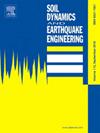Seismic evaluation of base-isolated nuclear power plants with various tuned inerter dampers
IF 4.2
2区 工程技术
Q1 ENGINEERING, GEOLOGICAL
引用次数: 0
Abstract
This paper investigated the seismic performance of base-isolated nuclear power plants (NPPs) incorporating various tuned inerter dampers (TIDs), specifically focusing on the series inerter system (SIS), series-parallel inerter system-I (SPIS-I), and series-parallel inerter system-II (SPIS-II). These vibration control strategies were applied to the Hualong pressurized reactor 1000 (HPR1000) NPP with a base-isolated double-layer containment. The equations of motion of base-isolated NPP with different TIDs were derived, and the seismic response variances of the HPR1000 NPP with the three TIDs under white noise excitation were obtained. Furthermore, the parameters of the three TIDs were optimized by minimizing the dynamic response of the NPP. The optimization results of dynamic response demonstrate that the SPIS-II reduces relative displacement of the base-isolated NPP significantly, while the SPIS-I has a better performance in minimizing absolute acceleration. Besides, the SIS shows a better vibration suppression effect when the inertial coefficient is relatively small. Furthermore, the detailed finite element method (FEM) models of the HPR1000 NPP with various vibration control strategies were established for validating the efficiency of the three TIDs. When these FEM models are subjected to safe-shutdown earthquake (SSE) loadings, the results demonstrate that TIDs reduce the seismic response of the HPR1000 NPP effectively. The novelty of this paper is presenting the rationality of the optimization results of the three TIDs, and providing the guidance for practical engineering by three-dimensional numerical modelling of HPR1000 structures. Noted that both vertical seismic motion and soil-structure interaction are not considered in this study, which requires a further investigation.
采用各种调谐干涉阻尼器的基础隔离核电站的地震评价
本文研究了采用各种调谐阻尼器(TIDs)的基隔震核电站(NPPs)的抗震性能,重点研究了串联阻尼器系统(SIS)、串并联阻尼器系统i (SPIS-I)和串并联阻尼器系统ii (SPIS-II)。将这些振动控制策略应用于基础隔离双层安全壳的华龙1000号压堆(HPR1000)核电站。推导了不同tid条件下基础隔震核电厂的运动方程,得到了三种tid条件下HPR1000核电厂在白噪声激励下的地震响应方差。此外,通过最小化NPP的动态响应,对三个tid的参数进行了优化。动态响应优化结果表明,SPIS-II可显著降低基础隔离NPP的相对位移,而SPIS-I在最小化绝对加速度方面具有更好的性能。此外,惯性系数较小时,SIS的减振效果较好。在此基础上,建立了HPR1000核电厂不同振动控制策略下的有限元模型,验证了三种tid的有效性。结果表明,在安全停堆地震荷载作用下,TIDs有效地降低了HPR1000核电站的地震响应。本文的新颖之处在于通过对HPR1000结构的三维数值模拟,展示了三种tid优化结果的合理性,并为实际工程提供了指导。需要注意的是,本研究没有考虑垂直地震运动和土-结构相互作用,这需要进一步的研究。
本文章由计算机程序翻译,如有差异,请以英文原文为准。
求助全文
约1分钟内获得全文
求助全文
来源期刊

Soil Dynamics and Earthquake Engineering
工程技术-地球科学综合
CiteScore
7.50
自引率
15.00%
发文量
446
审稿时长
8 months
期刊介绍:
The journal aims to encourage and enhance the role of mechanics and other disciplines as they relate to earthquake engineering by providing opportunities for the publication of the work of applied mathematicians, engineers and other applied scientists involved in solving problems closely related to the field of earthquake engineering and geotechnical earthquake engineering.
Emphasis is placed on new concepts and techniques, but case histories will also be published if they enhance the presentation and understanding of new technical concepts.
 求助内容:
求助内容: 应助结果提醒方式:
应助结果提醒方式:


